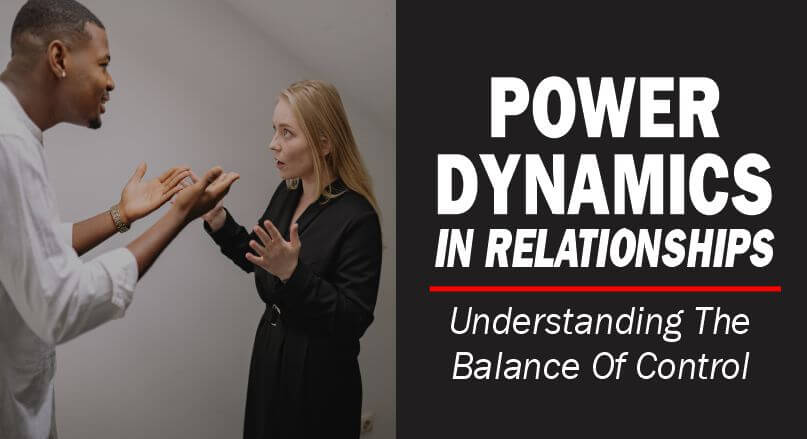Last updated on August 31st, 2025 at 11:20 am
Understand and apply power dynamics in relationships, where strength, wealth, knowledge, and status shape interactions and connections.
In human relationships, power dynamics play a pivotal role, in shaping the very foundation of our interactions.
Whether it be romantic partnerships, friendships, or professional connections, the distribution of power can profoundly influence the dynamics at play.
Power can manifest in various forms, such as physical strength, wealth, knowledge, or social status.
Understanding and navigating these power dynamics is crucial for encouraging healthy and balanced relationships.
We have detailed this succinct but informative article so you have a good understanding of power dynamics in relationships and how to navigate them.
Table of Contents
- What is Power Dynamics in Relationships?
- Types of Power Dynamics in Relationships
- Causes of Power Dynamics in Relationships
- Signs of Unhealthy Power Dynamics
- Effects of Power Imbalances on Relationships
- Healthy Power Dynamics in Relationships
- Strategies for Addressing Unhealthy Power Dynamics
- Gender and Cultural Considerations in Power Dynamics in Relationships
- Frequently Asked Questions
- Conclusion
What is Power Dynamics in Relationships?
Power dynamics in relationships is the distribution and exercise of power between individuals involved in a personal, professional, or social connection.
It covers how power is wielded, negotiated, and perceived within the relationship, irrespective of who the participants are.
Power can be derived from various sources, such as physical strength, financial resources, knowledge, social status, or emotional intelligence.
These dynamics can significantly impact the balance of control, decision-making, and influence within the relationship.
Understanding power dynamics is crucial for maintaining healthy relationships, as it allows you to navigate conflicts, establish boundaries, and promote equality and mutual respect.
Types of Power Dynamics in Relationships
Power dynamics in relationships can be categorized into different types, each with its own characteristics and implications.
Here are the explanations for each type:
1. Personal Power
Personal power in relationships refers to the influence an individual possesses based on their inherent qualities or acquired attributes.
It covers both inherent power, derived from natural characteristics like charisma or intelligence, and acquired power, gained through external means such as wealth or education.
Inherent Power: Inherent power refers to the natural qualities or characteristics that an individual possesses, which inherently influence others.
These qualities can include charisma, intelligence, physical attractiveness, or natural leadership abilities.
Inherent power is not dependent on external factors and is often seen as an innate form of influence.
Acquired Power: Acquired power, on the other hand, is gained through external means and efforts. It is obtained over time through resources, achievements, or personal development.
Acquired power can be derived from factors such as wealth, education, social connections, or professional accomplishments.
2. Interpersonal Power
Interpersonal power is a type of power dynamics in relationships that focuses on the influence individuals exert over each other through various means.
Understanding and navigating interpersonal power dynamics, including emotional power and decision-making power, is crucial for maintaining healthy relationships.
It involves recognizing and respecting the emotions and autonomy of both individuals, promoting open communication, and ensuring that decision-making processes are fair and inclusive.
It includes emotional power and decision-making power.
Emotional Power
Emotional power is the ability to influence others through emotions. It involves manipulating or leveraging emotions to gain control or advantage in a relationship.
Decision-making Power
Decision-making power is the ability to make choices and have control over important decisions within a relationship.
It can be based on factors such as expertise, authority, negotiation skills, or the ability to persuade others.
Sexual Power
Sexual power in relationships refers to the influence and control exerted through sexual attraction, intimacy, or the withholding of sexual favors.
3. Societal Power
Societal power is a type of power dynamics in relationships that stems from broader social structures and systems.
It covers gender power imbalances, economic power disparities, and racial and cultural power dynamics.
Let’s examine these briefly:
Gender Power Imbalances
Gender power imbalances refer to the unequal distribution of power between genders.
It involves societal norms, expectations, and stereotypes that disadvantage or oppress one gender over another.
Economic Power Disparities
Economic power disparities arise from inequalities in wealth, income, and financial resources.
It can create imbalances in relationships, where one individual may have more control, influence, or decision-making power due to their economic advantage.
Racial and Cultural Power Dynamics
Racial and cultural power dynamics involve the influence and privilege associated with specific racial or cultural identities.
It covers the systemic advantages or disadvantages that individuals or groups face based on their race or culture.
Related Posts
Body Language Signs that Reveal a Lot
Why Long-distance Relationships Fail
Irresistible Women Men Can’t Die to Have
Gut Feeling in Addressing Insecurity in Relationships
Why you are Being Exploited in your Relationship
Causes of Power Dynamics in Relationships

Power dynamics in relationships can arise from various causes. According to Psychology Today, women are more concerned about relationships and, therefore, are more loyal than men.
Here are some common factors that contribute to the emergence of power dynamics:
Social and Cultural Factors
Societal norms, cultural expectations, and gender roles can shape power dynamics in relationships.
Traditional gender roles, for example, may assign more power and decision-making authority to one gender over the other.
Cultural values and beliefs can also influence power dynamics by reinforcing certain hierarchies or expectations within relationships.
Unequal Distribution of Resources
Power imbalances can stem from disparities in resources such as wealth, education, or social status.
When one person has more access to resources, they may wield more power and influence within the relationship.
Economic disparities, for instance, can create power dynamics where the wealthier partner holds more control over financial decisions.
Communication and Assertiveness Styles
Differences in communication and assertiveness styles can contribute to power dynamics.
If you are more assertive or dominant in your communication, you may exert more influence and control over the other person.
Conversely, if you are more passive or accommodating, you may be more susceptible to being controlled or manipulated.
Personal Insecurities and Past Experiences
Personal insecurities, past traumas, or experiences can impact power dynamics.
If you have experienced abuse or trauma, you are more vulnerable to being controlled or manipulated in relationships.
Insecurities or low self-esteem can also lead to power imbalances, as one person may seek validation or control over the other.
Learned Behaviours and Family Dynamics
Power dynamics in relationships can be influenced by learned behaviours and family dynamics.
You may replicate power dynamics observed in your own family or relationships growing up.
If you witnessed one parent exerting control or dominance over the other, you may unconsciously replicate similar dynamics in your own relationships, thinking it’s what is obtainable everywhere.
Signs of Unhealthy Power Dynamics
Unhealthy power dynamics in relationships can be identified through various signs.
Recognizing these signs is crucial for identifying and addressing unhealthy power dynamics in relationships.
Here are explanations of some common indicators:
1. Recognizing the Abuser-victim Dynamic
Unhealthy power dynamics in relationships often involve an abuser-victim dynamic, where one person exerts control and dominance over the other.
The most powerful may use intimidation, threaten, or even physically abuse the other to maintain control and dominanc,e while the other feels trapped in fear while being powerless.
2. Passive-aggressive Behaviour
Passive-aggressive behaviour is a sign of unhealthy power dynamics, where you express anger, resentment, or frustration indirectly.
This can include behaviours like sarcasm, backhanded compliments, silent treatment, or intentionally withholding information, which undermines open communication and creates tension within the relationship.
3. Controlling Behaviour
Unhealthy power dynamics often involve controlling behaviour, where one person seeks to dominate and manipulate the other.
This can manifest as excessive jealousy, possessiveness, monitoring of activities, isolating the partner from friends and family, or making decisions without considering the other person’s input or autonomy.
4. Isolation and Manipulation
Another sign of unhealthy power dynamics in relationships involves isolation and manipulation.
The person exerting power may isolate their partner from support systems, making them dependent on them for validation and decision-making.
Manipulation tactics can include gaslighting, guilt-tripping, or distorting reality to gain control and undermine the other person’s confidence and autonomy.
Effects of Power Imbalances on Relationships
Power imbalances in relationships can have significant effects on various aspects of the relationship.
Here are explanations of some common effects:
1. Emotional and Psychological Effects
Power imbalances can lead to emotional and psychological distress for the individual who feels powerless or oppressed.
They may experience feelings of low self-esteem, anxiety, depression, or a sense of helplessness.
The person with more power may exhibit behaviours such as arrogance, entitlement, or a lack of empathy, which can negatively impact the emotional well-being of the other person.
2. Physical Effects of Power Imbalances in Relationships
In some cases, power imbalances can escalate to physical abuse or violence.
The person with more power may use physical force or intimidation to maintain control, resulting in physical harm or injuries to the other person.
This can have long-lasting physical consequences and pose a threat to the overall safety and well-being of the relationship.
3. Impact on Communication and Trust
According to Big Think, power imbalances can lead to a lack of trust and respect in the relationship, which can cause the person with more power to feel like they are not being appreciated or valued by their partner.
Power imbalances can hinder open and honest communication within the relationship.
The person with less power may feel afraid to express their thoughts, needs, or concerns, fearing negative consequences or retaliation.
This lack of communication can erode trust and create a toxic environment where issues remain unresolved, leading to further deterioration of the relationship.
In romantic relationships, power imbalances can lead to a lack of trust between partners.
The person with less power may feel manipulated, controlled, or betrayed, while the person with more power may struggle to trust the other person’s intentions or actions.
This breakdown of trust, of course, can create a cycle of resentment, suspicion, and relationship anxiety and further exacerbate the power imbalance.
Healthy Power Dynamics in Relationships
It is easy to recognize a healthy power balance in relationships
Healthy power dynamics in relationships are characterized by mutual respect, equality, effective communication, and the ability to navigate conflicts and disagreements.
Here are explanations of key aspects of healthy power dynamics:
1. Communication and Consent
Healthy power dynamics prioritize open and honest communication. Both individuals actively listen, express their thoughts and feelings, and respect each other’s boundaries.
Consent is a fundamental aspect, ensuring that decisions and actions are made willingly and with the agreement of all parties involved.
2. Mutual Respect and Equality
Healthy power dynamics are built on mutual respect, where both individuals value each other’s opinions, needs, and autonomy.
There is a recognition of each person’s inherent worth and an understanding that power is shared and not concentrated in one person.
Equality is encouraged through fair decision-making, shared responsibilities, and a commitment to addressing power imbalances.
3. Balancing Personal and Interpersonal Power
Irrespective of how disposed you are to your power and how willing you can use it, it requires a measure of balance.
Healthy power dynamics involve balancing personal power with interpersonal power.
Each individual recognizes and respects their own personal power, such as their strengths, skills, and boundaries, while also considering the impact of their actions on the relationship.
They actively work towards creating a harmonious balance where power is shared and used responsibly.
4. Resolving Conflicts and Disagreements
In healthy relationships, power dynamics, conflicts and disagreements are seen as opportunities for growth and understanding.
Both you and the next person engage in constructive dialogue, actively listen to each other’s perspectives, and seek mutually beneficial solutions.
Conflict resolution strategies, such as compromise, negotiation, and empathy, are employed to address differences and maintain the overall well-being of the relationship.
Related: Understanding Gut Feelings and Relationship Anxiety
Strategies for Addressing Unhealthy Power Dynamics
Addressing unhealthy power dynamics in relationships requires proactive strategies and a commitment to change.
Here are explanations of key approaches:
Self-Awareness and Self-Empowerment
Developing self-awareness is crucial in recognizing and understanding your own role in perpetuating or enabling unhealthy power dynamics.
By reflecting on your personal values, beliefs, and behaviours, you can identify areas for growth and take steps towards self-empowerment.
Seek Support and Counseling
Seeking support from trusted friends, family, or professionals can provide valuable guidance and perspective.
Couples therapy or individual counseling can help you navigate power imbalances, improve communication skills, and address underlying issues contributing to unhealthy dynamics.
Setting Boundaries
Establishing clear and healthy boundaries is essential in addressing power imbalances.
You should communicate your needs, expectations, and limits to your partner.
This includes defining personal boundaries regarding decision-making, autonomy, and emotional well-being.
Exiting Toxic Relationships
In some cases, when efforts to address unhealthy power dynamics prove ineffective or when the relationship becomes toxic and harmful, it may be necessary to consider taking a break or ending the relationship.
Related: Tips to Avoid the Friendzone
Gender and Cultural Considerations in Power Dynamics in Relationships
Gender and cultural considerations strongly influence power dynamics in relationships, shaping how individuals experience equality, autonomy, and respect.
Intersectionality highlights how overlapping identities such as gender, race, class, and sexuality intersect to create unique challenges and privileges, making it vital to understand diverse experiences.
Power dynamics are often reinforced by cultural stereotypes and gender norms that dictate roles and expectations, which can perpetuate inequality.
Challenging these norms is essential for dismantling harmful patterns and fostering inclusivity.
Real-world scenarios show how power imbalances manifest, such as managers undermining subordinates in workplaces or partners controlling finances in intimate relationships, leaving the other disempowered.
However, transformation is possible. Survivors of abuse can rebuild confidence and independence through support systems, while couples who challenge cultural traditions and share decision-making create healthier, more equitable partnerships.
Ultimately, recognizing and addressing these dynamics promotes fairness, strengthens relationships, and empowers individuals across different contexts.
Frequently Asked Questions
What is power dynamics in relationships?
Power dynamics in relationships refer to the distribution and exercise of power between individuals, influencing control, decision-making, and influence within the relationship.
What are the different types of power dynamic relationships?
The different types of power dynamics in relationships include personal power, interpersonal power, and societal power.
What are examples of power relationships?
Examples of power relationships can be seen in a boss-employee dynamic, a parent-child relationship, or a romantic partnership with imbalanced decision-making.
What are positive power dynamics in a relationship?
Positive power dynamics in a relationship involve mutual respect, effective communication, shared decision-making, and a balance of power that promotes equality and emotional well-being.
How can I address power imbalances in my relationship?
Open communication, setting boundaries, and seeking professional support can help address power imbalances and foster healthier dynamics.
What are some signs of unhealthy power dynamics in a relationship?
Signs include controlling behavior, emotional manipulation, an abuser-victim dynamic, and a lack of mutual respect and equality.
How do power dynamics affect the overall health of a relationship?
Unhealthy power dynamics can lead to emotional distress, low self-esteem, and a breakdown of trust and communication within the relationship.
Conclusion
Power dynamics in relationships shape the interactions and dynamics between individuals, influencing the balance of control, decision-making, and influence.
Understanding the various types, signs, and effects of power dynamics is crucial for encouraging healthy and balanced relationships.
Types of power dynamics include personal power, interpersonal power, and societal power.
Signs of unhealthy power dynamics can manifest as controlling behaviour, emotional manipulation, or an abuser-victim dynamic.
These power dynamics can have profound effects on emotional well-being, self-esteem, and the overall health of the relationship.
Exploring these aspects allows us to navigate relationships with awareness and promote healthier dynamics.
REFERENCES
- Power Dynamics In Relationships – How To Keep It Healthy
- The main types of unhealthy power dynamics in relationships
- The relationship power inventory: Development and validation
Pyo Merez (PsyD) is a distinguished adolescent and adult psychologist at the forefront of mental health advocacy.
With expertise in cognitive and developmental psychology, focusing on social relationships, cultural contexts, and individual differences, Pyo has dedicated his career to empowering adolescents and adults.
As a sought-after speaker and panelist, Pyo shares invaluable insights on issues affecting young people, contributing to a deeper understanding of mental health and well-being in today's society.

